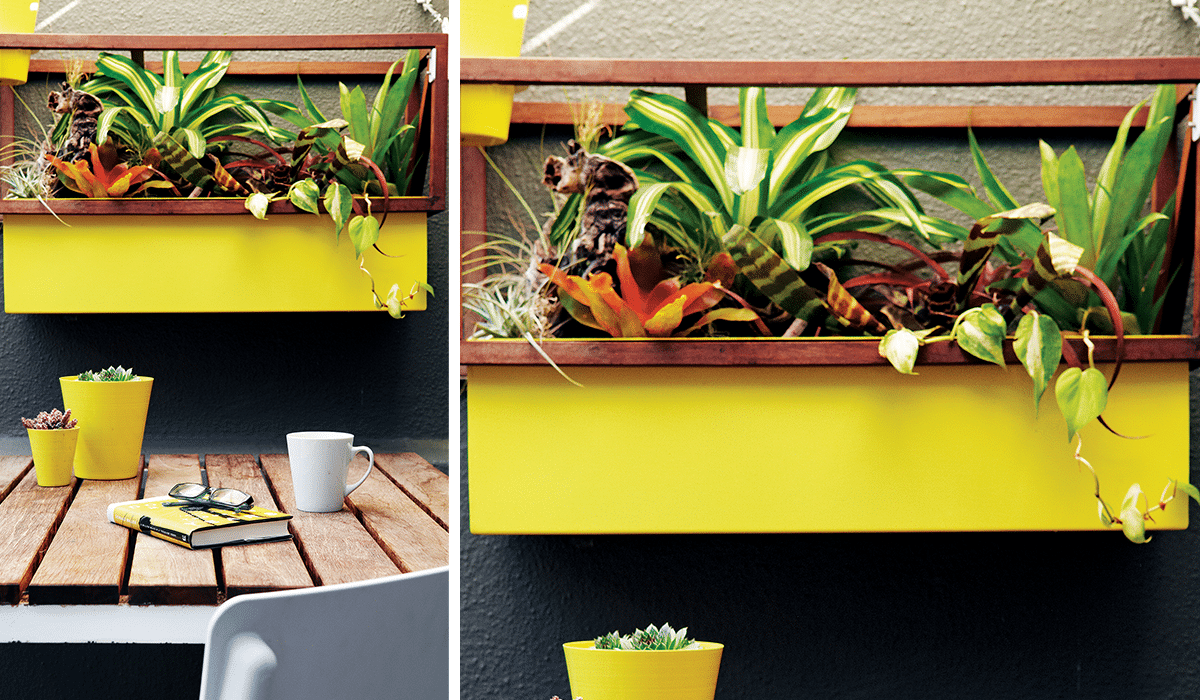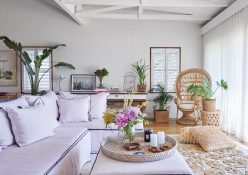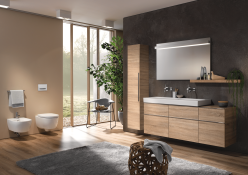You don’t need acres of space to reap the benefits of tending a garden. You can grow your own oasis if you live in an apartment with no soil space, or somewhere that has a tiny patch to call your own. It just takes some clever planning and preparation and you’ll soon be a proud plant parent.
Plants lend colour, create focal points and can be incorporated in containers, hanging baskets, on windowsills, mounted on a wall, or placed on pedestals at different heights to create texture in a room.
1. Size matters
It’s easier to grow plants in larger containers than smaller ones. Bigger pots can hold more soil, which stays moist for longer, and can better withstand temperature fluctuations. Smaller containers and hanging baskets might seem more convenient, but they do dry out much quicker, especially in summer, and will require more frequent watering.
Another consideration is the size of the plant’s root system. Plants can become ‘pot bound’ if their container is too small, which will stunt their growth, so check the fine print to judge just how big they’ll get.
When it comes to colour, go wild. But do take into account the fact that lighter-coloured containers will stay cooler than darker ones, which retain heat for longer. Think about how heavy the pot will be if you intend on moving it often, and make sure it’s not too weighty for its location. No one wants a sagging balcony or deck, no matter how gorgeous the bougainvillea gets.

2. Whisk the water away
Drainage is crucial. Without it, plants will become waterlogged, develop root rot and may die. Some containers have drainage holes, but if they don’t, then drill some yourself. They don’t need to be very big, but just large enough to let excess water drain out easily.
If you tend to get overzealous with the watering can, then you can also choose self-watering, double-walled containers. They are suited to plants that need frequent watering – simply add water to the outer pot (not too much), and the inner pot will absorb the water. This is usually better for smaller pots of hanging baskets and are ideal if you are often away.
3. Material matters
The material your containers are made of makes a difference – clay and terracotta are classics, but can be fragile and are also affected by temperature changes. Yes, they can crack in extreme heat or cold! They also retain heat, so plants in these containers may need to be watered more often in summer.
Concrete is hard-wearing and can be painted in different colours but can be very heavy, too. If you plan on rearranging things often, rather opt for a concrete-and-fibreglass mix.
Plastic is also a good choice as it’s affordable and lightweight, however thinner, harder plastic can become brittle with age.
Wood will offer some protection against rapid temperature change, but make sure to opt for rot-resistant or treated wood that won’t become waterlogged easily.
4. Prep your pots
Once you’ve chosen your containers, decide where you’ll place them. Once they’re loaded with soil, that’s likely where they’ll have to stay as they might be too heavy to move.
A good potting soil mix from the nursery is usually suitable for most plants, but check whether yours have any special soil requirements first. Many pots already have drainage holes at the base, in which case you may want to use a thin layer of mesh to prevent too much soil from washing out when plants are watered.
If your pot doesn’t have drainage holes, add a thin layer of gravel (2 cm) to the base before planting. The pot should be big enough to hold the plant in its entirety when removed from its original plastic container.
Add enough soil to cover the roots well, but don’t overfill the pot – be sure to leave some space to accommodate watering.

5. What to plant?
Nearly all plants, vegetables, trees, shrubs or herbs can be planted in pots, but compact or dwarf cultivars are best for smaller pots. Choose plants for the amount of sun and shade they’ll receive, and for the effect you want to create.
Trailing and climbing plants will create look striking, and flowering or perfumed plants will infuse your space with colour and fragrance. If you want a low-maintenance garden, succulents are easy to grow, don’t need a lot of attention and look impressive when grouped together.
PLANTS TO POT
These plants will do well in pots and containers, depending on the location and lighting conditions. Your local nursery can advise you on the best options for your set-up.
FULL SUN: Marigolds, nasturtiums, petunias, salvia, sunflower.
PARTIAL SHADE: Fuchsia, begonia, impatiens, mimulus, schizanthus.
Herbs like basil and coriander do well in pots, as do chillies, but don’t attempt to grow these unless you can tend to them regularly.
CARING FOR YOUR CONTAINER GARDEN
Water regularly: plants in pots dry out quickly. You can also add a layer of mulch to keep them wetter for longer.
Feed them: container gardens need regular feeding. Start with once every two weeks, then adjust according to how your plants respond.
Keep them looking good: remove dead leaves and flowers and prune if necessary. Also watch out for insects or pests.
Words by Lynda Ingham-Brown






